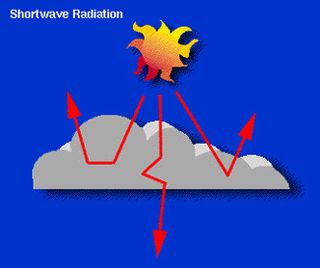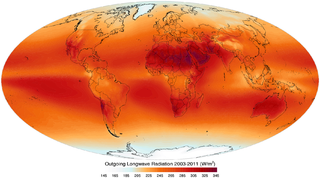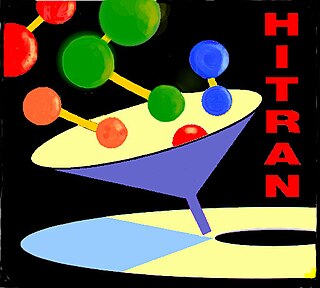Related Research Articles
The mesopause is the point of minimum temperature at the boundary between the mesosphere and the thermosphere atmospheric regions. Due to the lack of solar heating and very strong radiative cooling from carbon dioxide, the mesosphere is the coldest region on Earth with temperatures as low as -100 °C. The altitude of the mesopause for many years was assumed to be at around 85 km (53 mi), but observations to higher altitudes and modeling studies in the last 10 years have shown that in fact the mesopause consists of two minima - one at about 85 km and a stronger minimum at about 100 km (62 mi).

Numerical climate models use quantitative methods to simulate the interactions of the important drivers of climate, including atmosphere, oceans, land surface and ice. They are used for a variety of purposes from study of the dynamics of the climate system to projections of future climate. Climate models may also be qualitative models and also narratives, largely descriptive, of possible futures.

In meteorology, cloud forcing, cloud radiative forcing (CRF) or cloud radiative effect (CRE) is the difference between the radiation budget components for average cloud conditions and cloud-free conditions. Much of the interest in cloud forcing relates to its role as a feedback process in the present period of global warming.

Heat transfer is a discipline of thermal engineering that concerns the generation, use, conversion, and exchange of thermal energy (heat) between physical systems. Heat transfer is classified into various mechanisms, such as thermal conduction, thermal convection, thermal radiation, and transfer of energy by phase changes. Engineers also consider the transfer of mass of differing chemical species, either cold or hot, to achieve heat transfer. While these mechanisms have distinct characteristics, they often occur simultaneously in the same system.

Thermal radiation is electromagnetic radiation generated by the thermal motion of particles in matter. Thermal radiation is generated when heat from the movement of charges in the material is converted to electromagnetic radiation. All matter with a temperature greater than absolute zero emits thermal radiation. Particle motion results in charge-acceleration or dipole oscillation which produces electromagnetic radiation.

Radiative forcing is the change in energy flux in the atmosphere caused by natural or anthropogenic factors of climate change as measured by watts / metre2. It is a scientific concept used to quantify and compare the external drivers of change to Earth's energy balance. System feedbacks and internal variability are related concepts, encompassing other factors that also influence the direction and magnitude of imbalance.

In oceanic biogeochemistry, the continental shelf pump is proposed to operate in the shallow waters of the continental shelves, acting as a mechanism to transport carbon from surface waters to the interior of the adjacent deep ocean.
FUTBOLIN is a multi-level multiple scattering radiative transfer model for the calculation of line-by-line atmospheric emission/transmission spectra in planetary atmospheres. It has been developed by Javier Martín-Torres. It allows generating high-resolution synthetic spectra in the 0.3-1000 micrometre spectral range.

Entrainment is a phenomenon of the atmosphere which occurs when a turbulent flow captures a non-turbulent flow. It is typically used to refer to the capture of a wind flow of high moisture content, or in the case of tropical cyclones, the capture of drier air.

Outgoing Long-wave Radiation (OLR) is electromagnetic radiation of wavelengths from 3–100 μm emitted from Earth and its atmosphere out to space in the form of thermal radiation. It is also referred to as up-welling long-wave radiation and terrestrial long-wave flux, among others. The flux of energy transported by outgoing long-wave radiation is measured in W/m2. In the Earth's climate system, long-wave radiation involves processes of absorption, scattering, and emissions from atmospheric gases, aerosols, clouds and the surface.
An atmospheric radiative transfer model, code, or simulator calculates radiative transfer of electromagnetic radiation through a planetary atmosphere.

HITRAN molecular spectroscopic database is a compilation of spectroscopic parameters used to simulate and analyze the transmission and emission of light in gaseous media, with an emphasis on planetary atmospheres. The knowledge of spectroscopic parameters for transitions between energy levels in molecules is essential for interpreting and modeling the interaction of radiation (light) within different media.
Streamer is a radiative transfer code to calculate radiances (intensities) or irradiances in the atmosphere.
The Rapid Radiative Transfer Model (RRTM) is a validated, correlated k-distribution band model for the calculation of solar and thermal-infrared atmospheric radiative fluxes and heating rates. The Rapid Radiative Transfer Model for GCMs (RRTM-G) is an accelerated version of RRTM that provides improved efficiency with minimal loss of accuracy for application to general circulation models. The latter divides the solar spectrum into 14 bands within which a total of 112 pseudo-monochromatic calculations are performed, and in the thermal infrared 16 bands are used within which 140 pseudo-monochromatic calculations are performed. RRTM-G is used in a number of general circulation models worldwide, such as that of the European Centre for Medium-Range Weather Forecasts.
Robert D. Cess is professor emeritus of atmospheric sciences at Stony Brook University. He earned his bachelor of science degree in mechanical engineering from Oregon State University and his master's degree from Purdue University in Indiana in 1956. Cess received a Ph.D. from the University of Pittsburgh in 1959. He is a recognized leader in the fields of climate change and atmospheric radiation transfer. His research interests involve modeling of climate feedbacks that can either amplify or diminish global climate change, and interpreting surface and satellite remote sensing data.
Internal tides are generated as the surface tides move stratified water up and down sloping topography, which produces a wave in the ocean interior. So internal tides are internal waves at a tidal frequency. The other major source of internal waves is the wind which produces internal waves near the inertial frequency. When a small water parcel is displaced from its equilibrium position, it will return either downwards due to gravity or upwards due to buoyancy. The water parcel will overshoot its original equilibrium position and this disturbance will set off an internal gravity wave. Munk (1981) notes, "Gravity waves in the ocean's interior are as common as waves at the sea surface-perhaps even more so, for no one has ever reported an interior calm."
RTTOV - the fast radiative transfer model for calculations of radiances for satellite infrared or microwave nadir scanning radiometers.
The Community Radiative Transfer Model (CRTM) is a fast radiative transfer model for calculations of radiances for satellite infrared or microwave radiometers.

ARTS is a widely used atmospheric radiative transfer simulator for infrared, microwave, and sub-millimeter wavelengths. While the model is developed by a community, core development is done by the University of Hamburg and Chalmers University, with previous participation from Luleå University of Technology and University of Bremen.
Schwarzschild's equation is used to calculate radiative transfer – energy transfer – through a medium in local thermodynamic equilibrium that both absorbs and emits electromagnetic radiation.
References
- Clough, S. A., M. W. Shephard, E. J. Mlawer, J. S. Delamere, M. J. Iacono, K. Cady-Pereira, S. Boukabara, and P. D. Brown, Atmospheric radiative transfer modeling: a summary of the AER codes, Short Communication, J. Quant. Spectrosc. Radiat. Transfer, 91, 233-244, 2005.
- Clough, S.A. and M.J. Iacono, Line-by-line calculations of atmospheric fluxes and cooling rates II: Application to carbon dioxide, ozone, methane, nitrous oxide, and the halocarbons. J. Geophys. Res., 100, 16,519-16,535, 1995.
- Clough, S.A., M.J. Iacono, and J.-L. Moncet, Line-by-line calculation of atmospheric fluxes and cooling rates: Application to water vapor. J. Geophys. Res., 97, 15761-15785, 1992.